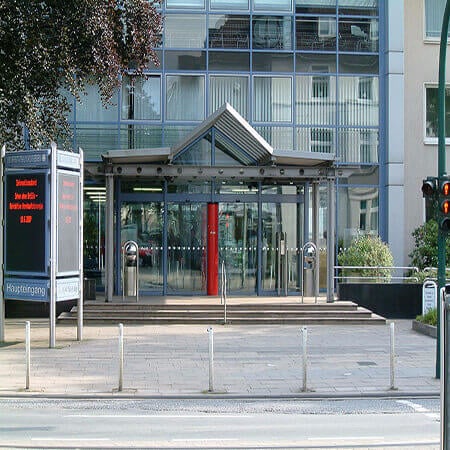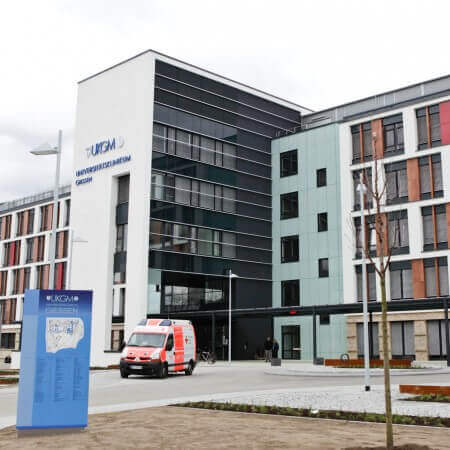Top Hospitals for Proton Therapy
Each hospital in this list meets Booking Health’s strict international standards: at least 250 surgeries per year, ISO‑certified quality management, and documented survival outcomes. Our medical board then ranks the clinics by clinical expertise, technology, and patient‑satisfaction scores.

According to the authoritative Focus magazine the University Hospital Essen ranks among the top German hospitals! With 27 specialized departments and 24 institutes, the hospital in Germany is a maximum care medical facility. The hospital has 1,300 beds for inpatient treatment. A highly qualified medical team of more than 6,000 e









Proton therapy for brain tumor
Price from:
85007
Go to the program Proton therapy for malignant tumour
Price from:
85471
Go to the program Treatment of breast cancer with proton therapy
Price from:
85550
Go to the program Treatment of chondrosarcoma with proton therapy
Price from:
85621
Go to the program Treatment of esophageal cancer with proton therapy
Price from:
85455
Go to the program Treatment of liver cancer with proton therapy
Price from:
85590
Go to the program Treatment of lung cancer with proton therapy
Price from:
85357
Go to the program Treatment of nasopharyngeal cancer with proton therapy
Price from:
85573
Go to the program Treatment of pancreatic cancer with proton therapy
Price from:
85600
Go to the program Treatment of prostate cancer with proton therapy
Price from:
85380
Go to the program Treatment of skull base chordoma with proton therapy
Price from:
85815
Go to the program Treatment of soft tissue sarcoma with proton therapy
Price from:
85632
Go to the program 
According to Focus magazine, the University Hospital Heidelberg ranks among the top five hospitals in Germany! The hospital is one of the most advanced and reputable medical institutions not only in Germany, but throughout Europe. There are more than 43 specialized departments and 13 medical institutes, which cover all fields of
Proton therapy for brain tumor
Price from:
0
Go to the program Proton therapy for malignant tumour
Price from:
0
Go to the program Treatment of breast cancer with proton therapy
Price from:
0
Go to the program Treatment of chondrosarcoma with proton therapy
Price from:
0
Go to the program Treatment of esophageal cancer with proton therapy
Price from:
0
Go to the program Treatment of liver cancer with proton therapy
Price from:
0
Go to the program Treatment of lung cancer with proton therapy
Price from:
0
Go to the program Treatment of nasopharyngeal cancer with proton therapy
Price from:
0
Go to the program Treatment of pancreatic cancer with proton therapy
Price from:
0
Go to the program Treatment of prostate cancer with proton therapy
Price from:
0
Go to the program Treatment of skull base chordoma with proton therapy
Price from:
0
Go to the program Treatment of soft tissue sarcoma with proton therapy
Price from:
0
Go to the program 
The University Hospital Giessen UKGM positions itself as an ultramodern medical facility with outstanding quality of medical care. The hospital presents almost all areas of medicine, ranging from ophthalmology to traumatology and dentistry. The priorities of the hospital’s activities include surgery, neurosurgery, oncology
Proton therapy for brain tumor
Price from:
86549
Go to the program Proton therapy for malignant tumour
Price from:
86396
Go to the program Treatment of breast cancer with proton therapy
Price from:
86293
Go to the program Treatment of chondrosarcoma with proton therapy
Price from:
86092
Go to the program Treatment of esophageal cancer with proton therapy
Price from:
86212
Go to the program Treatment of liver cancer with proton therapy
Price from:
86125
Go to the program Treatment of lung cancer with proton therapy
Price from:
86224
Go to the program Treatment of nasopharyngeal cancer with proton therapy
Price from:
86141
Go to the program Treatment of pancreatic cancer with proton therapy
Price from:
86244
Go to the program Treatment of prostate cancer with proton therapy
Price from:
86188
Go to the program Treatment of skull base chordoma with proton therapy
Price from:
86190
Go to the program Treatment of soft tissue sarcoma with proton therapy
Price from:
86148
Go to the program 

